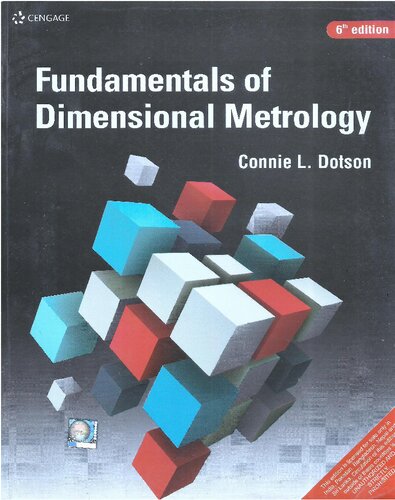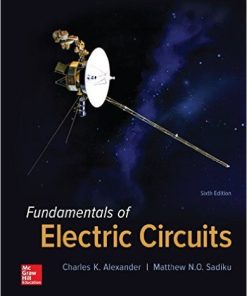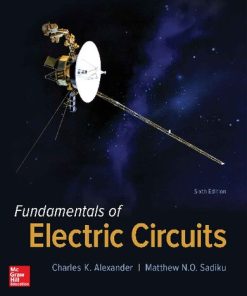(EBOOK PDF)Fundamentals Of Dimensional Metrology 6Th Edition by Connie Dotson 9386668548 9789386668547 full chapters
$50.00 Original price was: $50.00.$25.00Current price is: $25.00.
Fundamentals Of Dimensional Metrology 6Th Edition by Connie Dotson – Ebook PDF Instant Download/Delivery: 9386668548, 9789386668547
Full download Fundamentals Of Dimensional Metrology 6Th Edition after payment

Product details:
• ISBN 10:9386668548
• ISBN 13:9789386668547
• Author:Connie Dotson
Brand New International Paper-back Edition same as per description, **Economy edition, May have been printed in Asia with cover stating Not for sale in US. Legal to use despite any disclaimer on cover. Save Money. Contact us for any queries. Best Customer Support! All Orders shipped with Tracking Number.
Fundamentals Of Dimensional Metrology 6Th Table of contents:
Ch 1: Measurement and Metrology
1-1 Measurement as the Language of Science
1-2 The Uses of Measurement
1-3 Communications about Measurement
1-4 Acts and Applications of Measurement
1-5 Codification of Measurement
1-6 A Look Ahead
Summary
End-of-Chapter Questions
Ch 2: Language and Systems of Measurement
2-1 Communications Considerations
2-2 How Big?
2-3 How Far Apart?
2-4 From End to End
2-5 Accuracy, Precision, and Reliability
2-6 Accuracy versus Precision
2-7 The Evolution of Standards
2-8 The Origin of the Metric System
2-9 The Legality of the Metric System in the United States
2-10 The International Inch
2-11 Fundamental Criteria
2-12 The Best System
2-13 Practical Criteria
2-14 The Decimal-Inch System
2-15 Metrological Considerations
2-16 Computational Considerations
2-17 Rounding off Numerical Values
Summary
End-of-Chapter Questions
Ch 3: Measurement and Tolerances
3-1 The Meaning of Tolerance
3-2 Geometric Dimensioning and Tolerancing
3-3 The Application of Geometric Tolerancing
Summary
End-of-Chapter Questions
Ch 4: Statistics and Metrology
4-1 Basic Statistics Second Line
4-2 Probability
4-3 Acceptance Sampling
Summary
End-of-Chapter Questions
Ch 5: Measurement with Graduated Scales and Scaled Instruments
5-1 The Steel Rule
5-2 The Role of Error
5-3 Scaled Instruments
5-4 Calipers: The Original Transfer Instruments
Summary
End-of-Chapter Questions
Ch 6: Vernier Instruments
6-1 Vernier Instruments
6-2 Vernier Caliper
6-3 Vernier Depth Gage
6-4 The Vernier Height Gage
6-5 Three Elements of Measurement
Summary
End-of-Chapter Questions
Ch 7: Micrometer Instruments
7-1 Micrometers
7-2 Using the Micrometer
7-3 Care of Micrometers
7-4 Variations of Micrometers
Summary
End-of-Chapter Questions
Ch 8: Development and Use of Gage Blocks
8-1 Development of Gage Blocks
8-2 Modern Gage Blocks
8-3 Calibration of Gage Blocks
8-4 Gage Block Applications
8-5 Combining Gage Blocks
Summary
End-of-Chapter Questions
Ch 9: Calibration
9-1 The Role of Error
9-2 Basic Calibration Procedure
9-3 Record and Correct Calibration Readings
Summary
End-of-Chapter Questions
Ch 10: Measurement by Comparison
10-1 The Dial Indicator
10-2 Selection of a Dial Indicator
10-3 Use of Dial Indicators
10-4 Calibration of Dial Indicators
10-5 Accessories and Attachments
10-6 Constructive Use of Error
Summary
End-of-Chapter Questions
Ch 11: Reference Planes
11-1 Background
11-2 Flatness
11-3 Perpendicularity
11-4 Modern Reference Planes
11-5 How Flat is Flat
Summary
End-of-Chapter Questions
Ch 12: Angle Measurement
12-1 Angles
12-2 Angle Measurement
12-3 The Level
12-4 The Protractor
12-5 Trigonometric Functions
12-6 Sine Bars and Plates
12-7 Mechanical Angle Measurement
12-8 Measurements to Seconds of Arc
12-9 Accuracy and Precision in Angle Measurement
12-10 The Degree, Grad, and Gon
Summary
End-of-Chapter Questions
Ch 13: Surface Measurement
13-1 Background
13-2 Surface Evaluation, Stylus Method
13-3 Numerical Values for Assessment
13-4 Surface Texture Specimens
13-5 Surface Evaluation, Other Methods
13-6 Roundness
13-7 Notation for Surface Assessment
Summary
End-of-Chapter Questions
Ch 14: High-Amplification Comparators
14-1 High-Amplification Comparators
14-2 Electronic Measurement
14-3 Applications Unique to Electronic Measurement
14-4 Metrological Advantages of Multiple Scales
Summary
End-of-Chapter Questions
Ch 15: Pneumatic Measurement
15-1 Background
15-2 From History to Semantics
15-3 Principles of Pneumatic Instruments
15-4 Application of Pneumatic Metrology
15-5 Metrological Advantages of Pneumatic Comparators
15-6 Reading the Pneumatic Comparator
Summary
End-of-Chapter Questions
Ch 16: Optical Flats and Optical Alignment
16-1 The Importance of Standards
16-2 Light Waves as Standards
16-3 Measurement with Optical Flats
16-4 Applications of Optical Flat Measurement
16-5 Principles of Optical Metrology
16-6 Alignment Telescope-Straightness Measurement
16-7 Optical Squares-Squareness
16-8 Sight Level-Plumbness
16-9 Optical Polygons-Angles
16-10 Jig Transit-Planes
16-11 Theodolite-Angles and Planes
16-12 Beyond Vision
Summary
End-of-Chapter Questions
Ch 17: Optical Metrology
17-1 Principles of the Microscope
17-2 Applications
17-3 Comparison of Optical Comparators and Microscopes
17-4 Optical Considerations
17-5 Applications of the Optical Comparator
17-6 The Accuracy of Optical Comparators
17-7 Machine Vision Systems
Summary
End-of-Chapter Questions
Ch 18: Coordinate Measuring Machines
18-1 Background
18-2 The Role of Coordinate Measuring Machines
18-3 Types of Coordinate Measuring Machines
18-4 Modes of Operation
18-5 Metrological Features
18-6 Future Expectations
Summary
End-of-Chapter Questions
Appendices
Appendix A: Decimal Equivalents
Appendix B: Conversion Table
Appendix C: Geometric Optics
Appendix D
Appendix E: Trigonometric Functions
Appendix F: Metrology Web Sites
Appendix G: Bibliography
Glossary
Index
Read Less
People also search for Fundamentals Of Dimensional Metrology 6Th:
fundamentals of dimensiona
fundamentals of dimensional metrology 6th edition pdf
fundamentals of dimensional metrology 6th edition
fundamentals of dimensional metrology pdf
fundamentals of dimensional metrology 6th edition answers
Tags:
Fundamentals of Dimensional,Dimensional Metrology,Connie Dotson
You may also like…
Engineering
Fundamentals of Thermal Fluid Sciences 6th Edition by Yunus Cengel 1264131348 9781264131341
Biology and other natural sciences - Plants: Agriculture and Forestry
Uncategorized
Engineering - Electrical & Electronic Engineering












